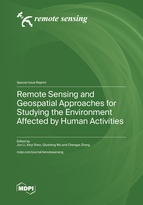Remote Sensing and Geospatial Approaches for Studying the Environment Affected by Human Activities
A special issue of Remote Sensing (ISSN 2072-4292). This special issue belongs to the section "Remote Sensing and Geo-Spatial Science".
Deadline for manuscript submissions: closed (30 June 2023) | Viewed by 24052
Special Issue Editors
Interests: remote sensing of ecology and environment; geospatial analysis; ecology and environment in mining areas; machine learning; spatiotemporal data mining
Interests: flood inundation modeling and observatory; Humans, Disasters, and the Built Environment; microwave remote sensing; artificial intelligence; compound flooding
Special Issues, Collections and Topics in MDPI journals
Interests: remote sensing; GIS; wetland hydrology; LiDAR; google earth engine
Special Issues, Collections and Topics in MDPI journals
Interests: quantitative remote sensing; multi- and hyper-spectral remote sensing; remote sensing of vegetation; machine learning; radiative transfer model
Special Issues, Collections and Topics in MDPI journals
Special Issue Information
Dear Colleagues,
During the past several decades, intensive human activities, such as urban expansion, industrial emissions, farming, deforestation, mining, tourism and land reclamation, have significantly altered the natural environment. In other words, the environmental changes have been deeply coupled with a variety of human activities, leading to various environmental problems, such as arable land degradation, deforestation, air pollution, and water pollution. Hence, effective environmental protection and governance are vital in the areas with intensive human activities, especially in the environmentally vulnerable areas, such as farming-pastoral transitional zones, wetlands, arid and semi-arid areas, coastal zones, and alpine-cold regions. In this issue, we call for the papers which address the following problems: (1) How to monitor the environmental alteration by human activities at different spatiotemporal scales; (2) How to quantify, evaluate, and predict the impact of human activities on the environment; (3) How to decompose or evaluate the compound influence of various natural disturbance (e.g., heat stress, water stress, and topography) and human alteration (e.g., water conservancy projects, mining, deforestation) on the environment; and (4) What is the corresponding pattern or mechanism of the environmental evolution to different human activities.
Satellite and airborne remote sensing has proven to be a valuable tool for retrieving environmental parameters, and it has been widely used for monitoring environmental change at regional or global scales, with advantages of looking back in the long-time history and the time-space continuum. Geospatial approaches have been popularly used in analyzing the coupled effects from multiple factors based on remotely sensed images and other geospatial datasets. Both remote sensing and geospatial approaches are critical for interpreting the impact of human activities on the environment.
This special issue aims to enrich the current knowledge in the area of “Remote Sensing and Geospatial Approaches for Studying the Environment Affected by Human Activities”. We would like to invite you to contribute to this Special Issue of Remote Sensing by submitting original manuscripts, experimental work, and/or reviews in the related fields, from the perspectives of new theories, new datasets, new methods, new findings, and new applications. In this direction, the achievements in this special issue are expected to make scientific contributions to the environmental protection and governance affected by a variety of human activities.
Potential topics of the special issue include but are not limited to the following:
- Development of new theories or paradigms for investigating the environment affected by human activities based on remote sensing and geospatial approaches.
- Applications of new geospatial datasets for a better understanding of the environment affected by human activities.
- New methods for retrieving environmental parameters (fractional vegetation cover, vegetation biodiversity, vegetation biomass, air & soil & water pollution, soil moisture, soil erosion, etc.) by remote sensing, quantifying and evaluating environmental quality, deriving the pattern/mechanism of environmental change, and decomposing the compound influence from driving factors.
- New findings about the responding pattern or mechanism of the environmental evolution to different human activities.
- New geospatial or remote sensing tools, software, platforms for studying the environment affected by human activities.
Dr. Jun Li
Dr. Xinyi Shen
Dr. Qiusheng Wu
Dr. Chengye Zhang
Guest Editors
Manuscript Submission Information
Manuscripts should be submitted online at www.mdpi.com by registering and logging in to this website. Once you are registered, click here to go to the submission form. Manuscripts can be submitted until the deadline. All submissions that pass pre-check are peer-reviewed. Accepted papers will be published continuously in the journal (as soon as accepted) and will be listed together on the special issue website. Research articles, review articles as well as short communications are invited. For planned papers, a title and short abstract (about 100 words) can be sent to the Editorial Office for announcement on this website.
Submitted manuscripts should not have been published previously, nor be under consideration for publication elsewhere (except conference proceedings papers). All manuscripts are thoroughly refereed through a single-blind peer-review process. A guide for authors and other relevant information for submission of manuscripts is available on the Instructions for Authors page. Remote Sensing is an international peer-reviewed open access semimonthly journal published by MDPI.
Please visit the Instructions for Authors page before submitting a manuscript. The Article Processing Charge (APC) for publication in this open access journal is 2700 CHF (Swiss Francs). Submitted papers should be well formatted and use good English. Authors may use MDPI's English editing service prior to publication or during author revisions.
Keywords
- environment
- ecology
- human activities
- remote sensing
- GIS
- geospatial analysis









